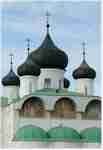
|
||
| Lindgren Slavic Studies | ||
| Lindgren Slavic Studies > Early Christian Saints > Early Christian Saints … |

|
||
| Lindgren Slavic Studies | ||
Early Christian Saints in Russian Iconographic ManualsNelly LindgrenRussian iconographic manuals contain drawings or textual descriptions of the images and compositions and also technical instructions for the icon painter. Russian manuals are divided into two basic types: the pattern-book (licevoj podlinnik) and the text manual (tolkovyj podlinnik). Pattern-books contain the drawings of the motifs with a short commentary in the margins. Text manuals comprise more detailed information about saints, not only on their images but also on biographical details, and therefore constitute a less known part of the hagiographic literature.The corpus of Russian calendars and Russian iconographic manuals comprised predominantly Byzantine saints. The share of the Byzantine saints in the oldest Russian church calendars from the 13th century is usually about 95%, while the amount of the Russian saints is insignificant. These proportions are about the same until the beginning of the 19th century. However, in local Russian manuals a larger part (50% or more) consists of Russian saints, some of which were not even proclaimed. Descriptions in text manuals include features as age of a person, shape of hair and beard, kind of clothing, attributes, and colour of important details, but can also include descriptions of landscape, buildings, secondary figures and objects, biographical data and sometimes even a short vita. A comparison of descriptions in manuals of different age shows that some features are constant, while others are slightly varying. Descriptions demonstrate a great variety of the length and content for different images and motifs. The most important images cover several pages, while descriptions of Russian “new saints” are restricted to a few lines. The length and the content of descriptions were influenced by several factors as type of the motif, type of the manual, age of the manuscript and its geographic attachment. Text manuals are the result of compilation from many different sources: menologia, synaxaria, hagiographic literature, liturgical books and descriptions of actual paintings. The old classical Byzantine motifs had a long tradition of painting and a great amount of texts to compile. The sources on the “new saints” were poor and often restricted to oral tradition. The principle of the similarity to the archetype inherited from Byzantine aesthetics has got a practical aspect in Russian tradition: the well-known and frequently painted Byzantine saints were used as reference-types or archetypes for the Russian "new saints".
International Conference "Cults of Early Christian Saints from Central and South-Eastern Europe", Samokov, Sofia, August 22—24, 1999 |
Lindgren Slavic Studies > Early Christian Saints > Early Christian Saints …
|
http://www.geocities.com/nelly.lindgren
Designed for Internet Explorer, 5.0 Coded in HTML at Lindgren Labs Created 9 February 1998. Updated 12 July 2002. |
E-mail to Nelly Lindgren
|